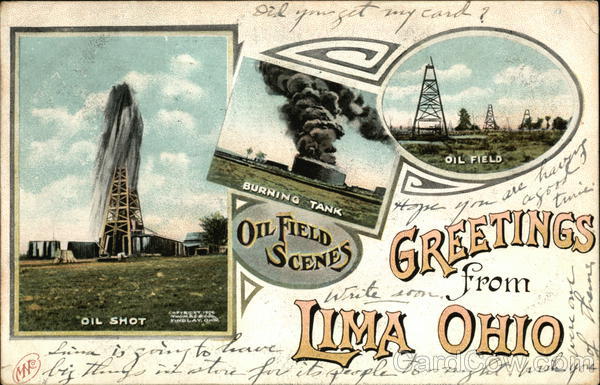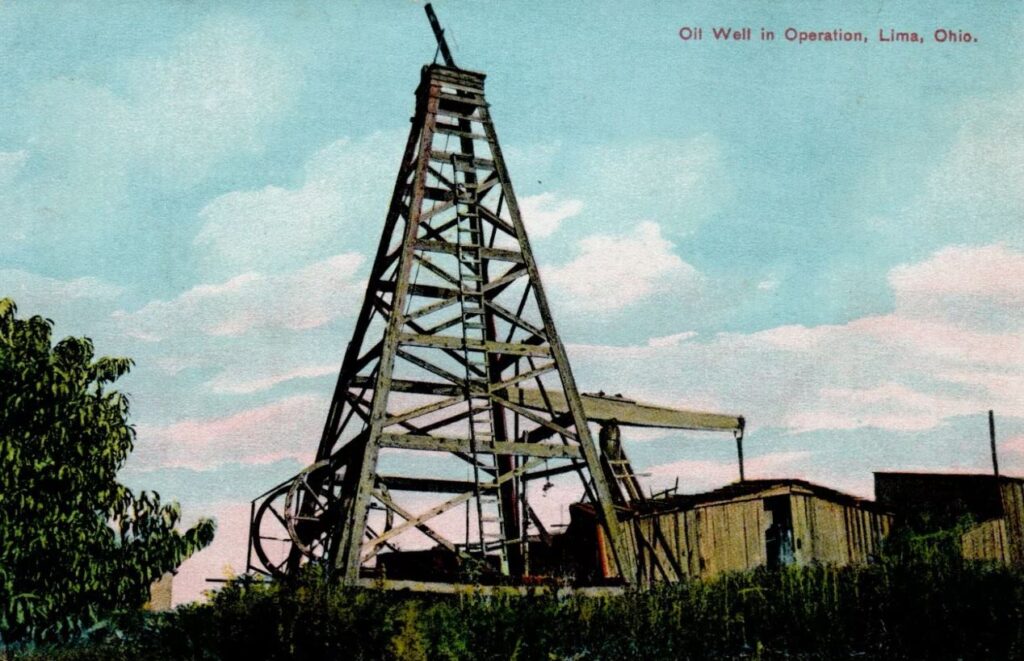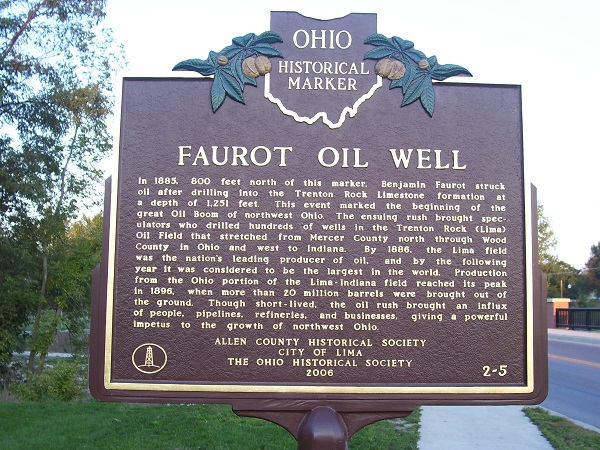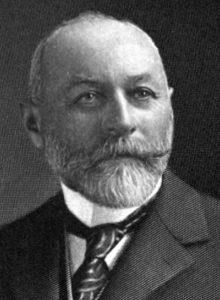Great Oil Boom of Lima, Ohio
The Ohio petroleum industry took off with an 1885 oilfield discovery in Allen County.
The “Great Oil Boom” of northwestern Ohio began when Benjamin C. Faurot, drilling for natural gas, found oil instead. His Ohio oil well of May 19, 1885, revealed the petroleum-rich Trenton Limestone at a depth of 1,252 feet.
“The oil find has caused much excitement and those who are working at the well have been compelled to build a high fence around it to keep curiosity seekers from bothering them,” Lima’s Daily Republican reported the next day.

Postcards promoted the oil prosperity of Lima, Ohio, which began in 1885 with a well that found an oilfield while drilling for natural gas. Circa 1910 postcard published by Robbins Bros., Boston.
“If the well turns out, as it looks now that it will, look out for the biggest boom Lima ever had,” the newspaper proclaimed. The oil excitement rivaled the Trenton formation in Indiana (learn more in Indiana Natural Gas Boom).
In February 1885, looking for cheap energy for a paper mill he owned, Faurot had brought in cable-tool drillers from Pennsylvania to bore a natural gas well,” noted a 2019 article in the Lima News. His company, Lima Paper Mill, produced straw board and egg cases at its plant on the Ottawa River east of downtown.
After the oil discovery, Faurot organized the Trenton Rock Oil Company. Excited Lima citizens organized their own oil exploration venture, the Citizens’ Oil Company, which allowed only 100 investors with none allowed to hold more than five shares of stock sold at $20 per share.
The Faurot well had revealed the Lima oilfield — soon the largest oil producer in the world.

Cable-tool equipment with a wooden derrick and walking beam, once common sights in Allen County, Ohio. Circa 1910 postcard published by Thomas & Co., Findlay.
“In May of 1885, Lima was a bustling community of some 8,000 people with a new courthouse and, thanks to leading businessman Benjamin C. Faurot, an opera house. It claimed a soon-to-be-electrified city street car system, railroad connections in all directions and a handful of newspapers,” noted the Lima News.
“The great enterprise of piping oil from the Lima fields to Chicago manufacturing establishments is now, in this year of 1888, being undertaken by the Standard Oil Company, who practically control all the oil territory around Lima,” noted one reporter at the time.

Wooden tanks (with a workover drilling rig in background) stored Lima oil before it was shipped to Cleveland refineries. Circa 1900 photo courtesy of Allen County Historical Society.
Among those attracted to Lima was the future four-time mayor of Toledo, Samuel Jones, who helped found the Ohio Oil Company (Marathon), patented an improved oil production technology, and became widely known as “Golden Rule” Jones of Ohio.
According to historian Richard Timberlake Jr., the “Panic of 1893” was a serious economic depression in the United States. Like a similar nationwide financial collapse two decades earlier, it was marked by the overbuilding of railroads, resulting in a series of bank failures.

In 2006, the Ohio Historical Society dedicated a Faurot oil well marker at 835 East North Street in Lima.
By 1886, Lima was the most productive oilfield in America after producing more than 20 million barrels of oil. Much of the oil was “heavy” — thick and sulfurous — but by the following year Lima oilfields led the world in production.
Although short-lived, “the oil rush brought an influx of people, pipelines, refineries, and businesses, giving a powerful impetus to the growth of northwest Ohio,” concluded the Allen County Historical Society.
After developing a new method for refining the heavy Lima oil, Standard Oil Company of New Jersey began construction on its Whiting refinery in 1889.
The company used improved pipeline technologies to deliver refined Lima oil to the 1893 Columbian Exposition in Chicago. There, at 72.5 cents per barrel, Standard Oil fueled the world’s largest steam boiler installation at the time. Chicago’s fair ultimately attracted 27.5 million visitors.
Refining Sulfurous “Lima Oil”
An emigrant German chemist would bring Ohio oil riches to John D. Rockefeller. On February 21, 1887, Herman Frasch applied to patent a new process for eliminating sulfur from “skunk-bearing oils.”

Inventor and mining engineer Herman Frasch (1851-1914), the Standard Oil chemist later known as the “Sulfur King.”
The former employee of Standard Oil of New Jersey was quickly rehired. Rockefeller had acquired some of the Lima oilfields for bargain prices because the wells produced a thick, sulfurous oil. Despite its difficulty to refine, the petroleum tycoon had accumulated a 40-million-barrel stockpile of the cheap, sour “Lima oil.”
Standard Oil Company bought Frasch’s patent for a copper-oxide refining process to “sweeten” the oil. By the early 1890s, the company’s new Whiting oil refinery east of Chicago was producing odorless kerosene from desulfurized oil, making Rockefeller a fortune.
Paid in Standard Oil shares and becoming very wealthy, Frasch moved to Louisiana — where the skilled chemist and mining engineer invented a new method to extract sulfur from underground deposits by injecting superheated water into wells. By 1911, multimillionaire Frasch was known as the “Sulfur King.”
In 2006, the Allen County Historical Society placed an Ohio historical marker near Benjamin C. Faurot’s oilfield discovery well site at the North Street crossing of the Ottawa River in Lima.
Grand Lake St. Marys in Ohio — the largest man-made body of water in the world — supported commerce on the Erie Canal beginning in 1845. By the late 1880s, Mercer County was producing oil from wells pumping on platforms on the lake. Learn more in Ohio Offshore Oil wells.
_______________________
Recommended Reading: Ohio Oil and Gas (2008); Where it All Began: The story of the people and places where the oil & gas industry began: West Virginia and southeastern Ohio (1994); Herman Frasch -The Sulphur King (2013). Your Amazon purchase benefits the American Oil & Gas Historical Society. As an Amazon Associate, AOGHS earns a commission from qualifying purchases.
_______________________
The American Oil & Gas Historical Society (AOGHS) preserves U.S. petroleum history. Please become an annual AOGHS supporter and help maintain this energy education website and expand historical research. For more information, contact bawells@aoghs.org. Copyright © 2025 Bruce A. Wells.
Citation Information – Article Title: “Great Oil Boom of Lima Ohio.” Authors: B.A. Wells and K.L. Wells. Website Name: American Oil & Gas Historical Society. URL: https://aoghs.org/petroleum-pioneers/great-oil-boom-of-lima-ohio. Last Updated: May 14, 2025. Original Published Date: May 19, 2019.



